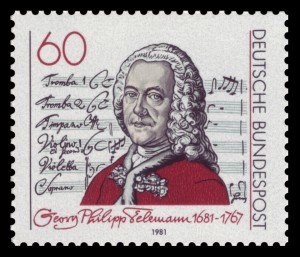 “Minors of the Majors” invites you to discover compositions by the great classical composers that for one reason or another have not reached the musical mainstream. Please enjoy, and keep listening!
“Minors of the Majors” invites you to discover compositions by the great classical composers that for one reason or another have not reached the musical mainstream. Please enjoy, and keep listening!
In 1723, the city council of Leipzig was looking to fill the position of the director of music, which included the appointment of a cantor at the church of St. Thomas. According to the job description, they were hoping to hire a “prolific” and “modern” composer. Not surprisingly—their choice was unanimous—they offered the position to Georg Philipp Telemann (1681-1767), considered the greatest living composer besides Georg Friedrich Handel. Since Telemann’s application to Leipzig had only been a ploy to secure a pay rise from his Hamburg employer, he quickly turned down the offer, and Leipzig was forced to approach J.S. Bach.
Telemann’s primary reason for staying in Hamburg was connected with his printing and publishing business. Initially, he started publishing literary work but in due course issued forty-six editions of his own works and distributed them through an extensive network of agents across Europe. As I have written elsewhere, Telemann was forced to dissolve his publishing business in 1740 to repay the large gambling debts accumulated by his second wife, Maria Catherina Textor! Telemann’s enviable international reputation rests on roughly 3600 compositions, which include approximately 130 “Ouvertures” that make up the great part of his orchestral output.
TWV (Telemann Werkverzeichnis) 55:a1, dating from around 1725, was originally scored for strings and basso continuo, but various arrangements do exist. This a-minor Overture unfolds as a loose collection of stylized dances arranged in the form of a “Suite.” The opening “Overture” movement, with its characteristic dotted rhythm is contrasted by a lively and entertaining Allegro, and concludes with an embellished statement of the opening theme. A charming “Rondeau” featuring a simple refrain structure is followed in quick succession by the French-inspired “Gavotte” and the Italianate “Courante.” The “Rigaudon,” a French dance in quick duple meter swiftly gives way to a “Forlane”—an Italian folk dance originating in the Friuli Venezia Giulia region—before this delightful composition concludes with a stately “Menuet.”
Georg Philipp Telemann: Overture in A minor, TWV 55:a1
You May Also Like
- Minors of the Majors
Pyotr Ilyich Tchaikovsky: String Quartet No. 2, Op. 22 Within Pytor Ilyich Tchaikovsky’s (1840-1893) considerable musical oeuvre, we surprisingly find very few chamber music compositions. - Minors of the Majors
Edward Elgar: Piano Quintet in A minor, Op. 84 Born in a small village near Worcester, Edward Elgar (1857-1934) initially earned his living by working in the office of a local solicitor. - Minors of the Majors
Francis Poulenc: Sonata for Trumpet, Horn and Trombone, Op.33 Jean Cocteau magnanimously announced in 1918, that his principal goal was the elimination of all foreign and specifically German elements from French music and culture. - Minors of the Majors
Franz Liszt: Cantantibus organis The 1860’s were not particularly kind to Franz Liszt. For one, the Tsar of Russia successfully blocked his long-awaited marriage to the Princess Carolyne Sayn-Wittgenstein.
More Anecdotes
-
 Shaking for Queen Victoria What happened when Baroness Bloomfield was asked to sing for the Queen?
Shaking for Queen Victoria What happened when Baroness Bloomfield was asked to sing for the Queen? - A Tour Around Vienna
Suppé: Ein Morgen, ein Mittag, ein Abend in Wien A work by the youthful Suppé -
 Desdemona in Real Danger What happened between Manuel Garcia and his daughter Maria Malibran?
Desdemona in Real Danger What happened between Manuel Garcia and his daughter Maria Malibran? -
 Adelina Patti and Her Teacup Puppy How would you respond if you receive a Chihuahua puppy after a performance?
Adelina Patti and Her Teacup Puppy How would you respond if you receive a Chihuahua puppy after a performance?



